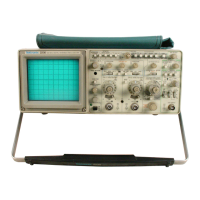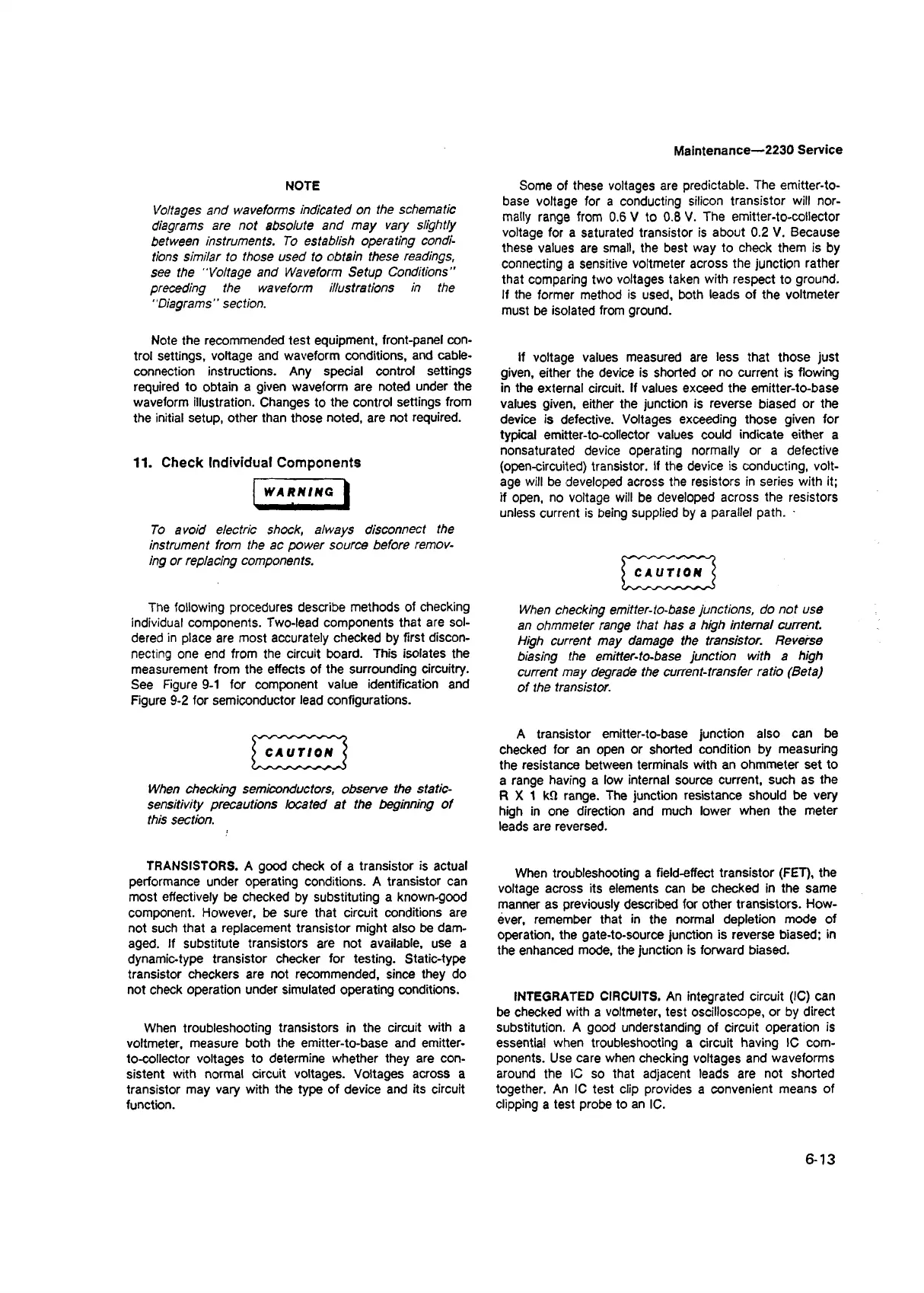Maintenance— 2230 Service
NOTE
Voltages and waveforms indicated on the schematic
diagrams are not absolute and may vary slightly
between instruments. To establish operating condi
tions similar to those used to obtain these readings,
see the " Voltage and Waveform Setup Conditions"
preceding the waveform illustrations in the
"Diagrams" section.
Note the recommended test equipment, front-panel con
trol settings, voltage and waveform conditions, and cable-
connection instructions. Any special control settings
required to obtain a given waveform are noted under the
waveform illustration. Changes to the control settings from
the initial setup, other than those noted, are not required.
11. Check Individual Components
WARNING
To avoid electric shock, always disconnect the
instrument from the ac power source before remov
ing or replacing components.
Some of these voltages are predictable. The emitter-to-
base voltage for a conducting silicon transistor will nor
mally range from 0.6 V to 0.8 V. The emitter-to-collector
voltage for a saturated transistor is about 0.2 V. Because
these values are small, the best way to check them is by
connecting a sensitive voltmeter across the junction rather
that comparing two voltages taken with respect to ground.
If the former method is used, both leads of the voltmeter
must be isolated from ground.
If voltage values measured are less that those just
given, either the device is shorted or no current is flowing
in the external circuit. If values exceed the emitter-to-base
values given, either the junction is reverse biased or the
device is defective. Voltages exceeding those given for
typical emitter-to-collector values could indicate either a
nonsaturated device operating normally or a defective
(open-circuited) transistor. If the device is conducting, volt
age will be developed across the resistors in series with it;
if open, no voltage will be developed across the resistors
unless current is being supplied by a parallel path. ■
CAUTION
The following procedures describe methods of checking
individual components. Two-lead components that are sol
dered in place are most accurately checked by first discon
necting one end from the circuit board. This isolates the
measurement from the effects of the surrounding circuitry.
See Figure 9-1 for component value identification and
Figure 9-2 for semiconductor lead configurations.
> CAUTION <
When checking semiconductors, observe the static-
sensitivity precautions located at the beginning of
this section.
When checking emitter-to-base junctions, do not use
an ohmmeter range that has a high internal current.
High current may damage the transistor. Reverse
biasing the emitter-to-base junction with a high
current may degrade the current-transfer ratio (Beta)
of the transistor.
A transistor emitter-to-base junction also can be
checked for an open or shorted condition by measuring
the resistance between terminals with an ohmmeter set to
a range having a low internal source current, such as the
R X 1 kfl range. The junction resistance should be very
high in one direction and much lower when the meter
leads are reversed.
TRANSISTORS. A good check of a transistor is actual
performance under operating conditions. A transistor can
most effectively be checked by substituting a known-good
component. However, be sure that circuit conditions are
not such that a replacement transistor might also be dam
aged. If substitute transistors are not available, use a
dynamic-type transistor checker for testing. Static-type
transistor checkers are not recommended, since they do
not check operation under simulated operating conditions.
When troubleshooting transistors in the circuit with a
voltmeter, measure both the emitter-to-base and emitter-
to-collector voltages to determine whether they are con
sistent with normal circuit voltages. Voltages across a
transistor may vary with the type of device and its circuit
function.
When troubleshooting a field-effect transistor (FET), the
voltage across its elements can be checked in the same
manner as previously described for other transistors. How
ever, remember that in the normal depletion mode of
operation, the gate-to-source junction is reverse biased; in
the enhanced mode, the junction is forward biased.
INTEGRATED CIRCUITS. An integrated circuit (1C) can
be checked with a voltmeter, test oscilloscope, or by direct
substitution. A good understanding of circuit operation is
essential when troubleshooting a circuit having 1C com
ponents. Use care when checking voltages and waveforms
around the 1C so that adjacent leads are not shorted
together. An 1C test clip provides a convenient means of
clipping a test probe to an 1C.
6-13

